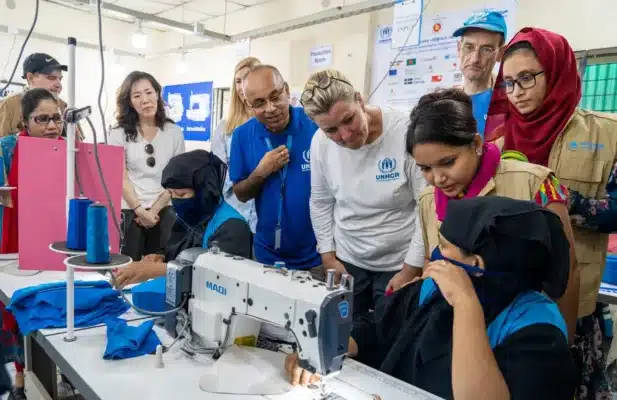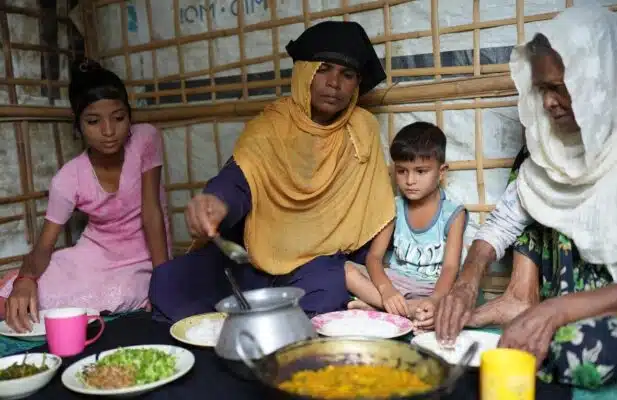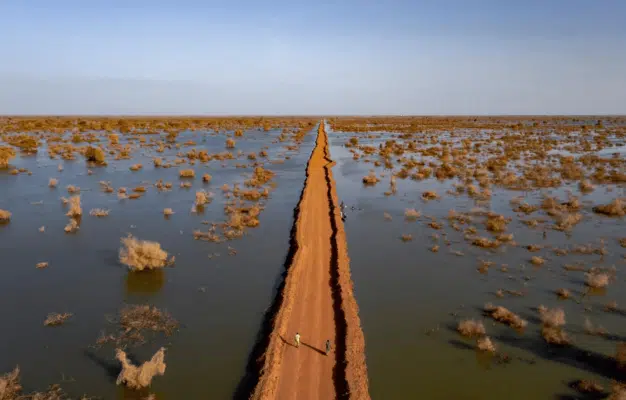
Ma Phyu Ma, a 37-year-old internally displaced Rohingya woman, stands amidst debris left behind by Cyclone Mocha in her village. © UNHCR/Reuben Lim Wende
In hard-hit Rakhine State, heavy rains will bring further hardships for hundreds of thousands of displaced people whose homes were damaged by Cyclone Mocha
By Reuben Lim Wende and Fabien Faivre in Sittwe, Rakhine State, Myanmar
Each year, between June and October, communities across Myanmar’s Rakhine State brace themselves for the near-daily deluges that sweep across the region during the monsoon season.
This year, the monsoon will bring unique challenges. In May, Cyclone Mocha, the most severe storm to hit Myanmar since Cyclone Nargis struck in 2008, made landfall on Rakhine State’s coast, causing widespread destruction.
Two months after it pummelled western Myanmar and southern Bangladesh, scenes of devastation can still be seen along roads radiating out from Sittwe, the state capital. Buildings with collapsed walls, missing roofs, and broken windows, interspersed with fallen electrical poles and other damaged infrastructure, dot the landscape.
Rakhine State is home to over 228,000 internally displaced people forced from their homes by bouts of intercommunal violence and conflict, including 157,000 ethnic Rohingya who have been living in overcrowded camps since 2012.
In Dar Paing, a camp for over 12,000 internally displaced Rohingya, debris and waterlogged soil stretches for as far as the eye can see. The camp was among the hardest hit by the cyclone, with 10 recorded deaths.
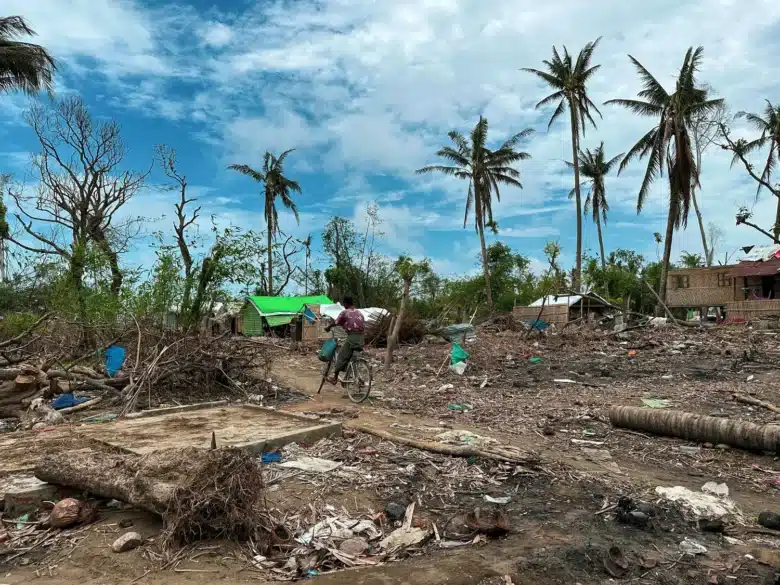
The impact of Cyclone Mocha on Dar Paing village is clear to see two months later. © UNHCR/Reuben Lim Wende
Sittwe Township, where Dar Paing is located, is at the confluence of three rivers that flow into the Indian Ocean – the Kaladan, Lay Myo and Mayu. The township was in the cyclone’s direct path and the accompanying storm surge triggered large-scale flooding in low-lying areas, causing a still-unknown number of casualties.
The community in Dar Paing had little time to mourn. With the monsoon rains already starting, residents of the camp are attempting to rebuild as best they can before the rainy season reaches its peak. But so far, only a fraction of damaged and destroyed shelters have been repaired, and thousands of people remain exposed to the elements.
“Our community is facing a lot of challenges. A lot of people need help to fix their roofs. The rains have arrived, and I am worried the situation will become unsustainable,” says Amraan, a community volunteer at the camp.
The monsoon season adds to the hardships faced by communities already living on the brink. The Rohingya face severe discrimination in Myanmar, impeding their access to fundamental rights. Many live in extreme poverty due to restrictions on their freedom of movement that have limited their ability to earn an income and access basic services such as education and healthcare.
UNHCR, the UN Refugee Agency, and local partners are redoubling efforts to assist both displaced and non-displaced communities by ramping up their assistance in areas where the de facto authorities have granted limited humanitarian access.
Work is ongoing in displacement camps and villages to quickly distribute tarpaulins and reconstruct communal longhouses. To date, over 100,000 people have received shelter assistance and basic household items.
“Needs for the monsoon this year are immense,” says Federico Sersale, UNHCR’s Head of Office in Sittwe. “While we have been able to reach a large number of people, increased access is needed so we can reach more communities and help them stay protected from the rain.”
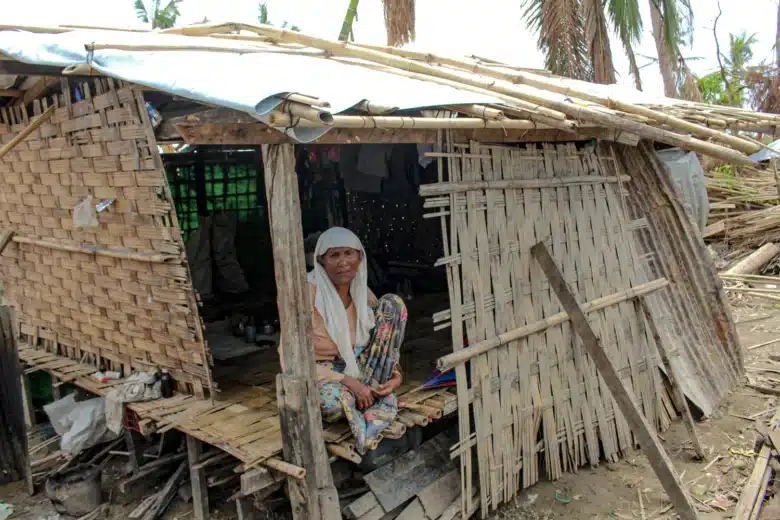
Abia Khartu sits in a makeshift shelter in Basara village. Her home was destroyed by the cyclone. © UNHCR/Fabien Faivre
Stories of loss and hardship abound all along the Rakhine coast. Abia Khartu, 63, an ethnic Rohingya from Basara village, lost her home and belongings to the cyclone. “[After the cyclone hit], I was in shock. I could not even find my house. Everything has been destroyed,” she says. She now lives in a makeshift shelter covered by a tarpaulin provided by UNHCR.
The space inside is spartan with few personal items besides a sleeping mat, bucket, blanket and kitchen set. These basic household items are distributed by UNHCR and partners to help communities cope with the loss of their belongings.
Longer-term solutions needed
No community in the path of the cyclone was spared. In downtown Sittwe, residents of Ngai Sa Rai Monastery worry about the damaged state of communal shelters and facilities. “The cyclone destroyed 10 of the 12 latrines here. Now, there are long waits every morning and we also lack bathing spaces for women,” Ma Soe Yai, 31, says.
The Buddhist monastery has been a refuge for 35 Rakhine families since they were displaced by the conflict between the Arakan Army and the Myanmar Armed Forces in 2020. Every communal longhouse at the site, each housing up to six families, sustained moderate to severe damage from the cyclone.
“It’s difficult for me to not worry. My roof leaks whenever it rains. If another storm comes, my shelter might collapse. I am miserable,” says Ma Soe Yai.
UNHCR is working closely with partner organizations to ensure tarpaulins are distributed, damaged shelters are reconstructed, and communal facilities are repaired.
Nearby in Set Yon Su Ward, an informal settlement where a small number of displaced ethnic Rakhine live, U Aye Dun, 65, has recently finished reconstructing his shelter which collapsed during the storm.
Topped with a white tarpaulin provided by UNHCR, it took him over two weeks to reconstruct his home. “I fixed everything myself. I have skills in bamboo craft, so I was able to rebuild my shelter without hiring additional labour. Otherwise, it would have been extremely expensive,” he says.
But as a daily wage labourer, U Aye Dun was unable to earn an income while he was rebuilding. Many others in this economically vulnerable community face the dilemma of having to forgo daily wages to fix their shelters so they can stay dry during the monsoon.
As commodity prices skyrocket in the aftermath of the cyclone, the provision of tarpaulins and basic household items has provided some much-needed relief to vulnerable families.
But more remains to be done. The UN estimates that at least 657,000 people across Rakhine need help with shelter, up from 390,000 people before the cyclone hit. Many are in hard-to-reach locations with limited humanitarian access.
“Our priority right now is to ensure people have a roof over their heads, but it is also important to continue to support displaced communities with long-term solutions, including access to basic rights and services, and help to return to their places of origin or preference,” says UNHCR’s Sersale.
Originally published by UNHCR on 31 July 2023.



